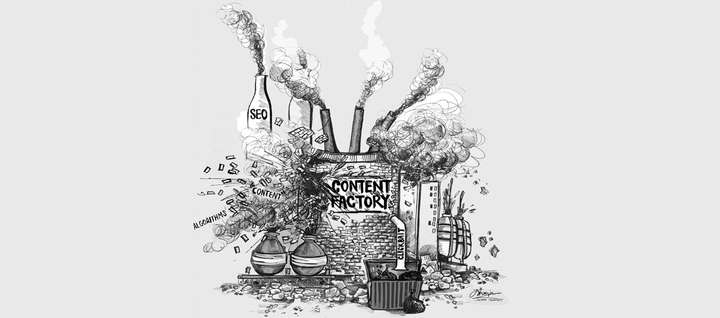
Letter From the Editor
By Mikki Halpin
Illustrated by Jasmine Thompson
Our editor in chief has some thoughts on things.
• • •
When was the last time you came across something really great on the Internet? If you’re like me, those moments are few and far between, and they usually come after you’ve sorted through a ton of repetitive, shallow stories that you settle for like peanuts at a bar you’re too lazy to leave for a proper meal. I know this sounds like a country song, but I’ve clicked on a million things and I just want to click on something good.
Well, there is a reason we’re not happy. No one is trying to make us happy! Stories aren’t made with the audience in mind. Readers are barely even thought of as human—instead it’s “traffic,” “shares,” or even “eyeballs.” At my first job in this industry, we all got a packet of reader mail to look through every morning. Now it’s “Don’t read the comments.”
Here’s the situation, in very broad strokes: The industry has dug itself into a hole. Publishers have set themselves up with traffic as a goal and advertising as a revenue stream. As more and more people spent more and more time online, there was more traffic to be had—and more money to be made—as long as they kept shoveling out content. And to get more eyeballs on more content, they had to start loading everything up with pop ups, pop overs, pop unders, content recommendation modules (that’s the weird grid of stories you see at the bottom of a page), and my personal favorite: 30-second ads on one-minute videos.
When publishers are beholden to clicks, it doesn’t matter if someone reads a story, as long as they’ve clicked on it. It doesn’t matter if a video is good or not, as long as there are five seconds of view time. They’ve gamed the algorithm and you’ve been counted, whether or not you got anything out of the experience. This numbers game is why we have (duh) clickbait. It’s also why we have content farms, stories that were written for search engines, and endless attempts to “break the Internet.”
Fuck that. What if we just break the system by focusing on making stuff that’s good? Why don’t we do fewer things, do them better, and make them count? Why don’t we give you, our readers, some credit and something worth spending your time on? Why don’t we work with a business model that’s audience-first and focused on passion and loyalty, not millennial clicks?
That’s what we’re doing here at Damn Joan. We’re monthly, so that we have enough time to make things we are truly proud of and want to share with our audience. Every issue is a collection of stories designed to keep your attention, not just get it. We love to experiment, so there are GIF-led essays, an interactive murder mystery that takes you off our site and into the darkest corners of the Web, and a visually-driven, immersive interface that lets you wander from story to story without hierarchies or verticals. We love creators, so we made a space where writers, artists, musicians, animators, and others with something to say can do it without pressure from us to make something that doesn’t feel right. We love telling stories that haven’t been told, from perspectives that don’t often get a platform, so we highlight work by women, people of color, the LGBTQ community, creators with disabilities, and people without fancy college degrees. And we love being kinda dorky, so there’s some pretty weird and hilarious stuff in every issue, alongside personal narratives, fashion, politics, and more.
All of these pieces, carefully crafted with you in mind, are connected by a different theme every month. Our first theme, Happy Death, is an exploration of contradictions and the ways that apparent opposites—grief and joy, fear and hope, endings and beginnings, destruction and creation—coexist in both magical and infuriating ways. The concept pushed us past expected narratives and topics and forced us into the unknown, looking for moments that are rarely seen or shared. It led us to stories about climate grief, orgasm quests, and fashion in a post-trend world. We also found a Barbie funeral, the tale of a heroic cheese worm, poisonous perfumes, and more.
Happy Death also signals, to us, a new era in publishing. There are are new brands full of passionate, independent thinking all over—places like Topic, The Front, Lenny, and Them. Maybe the end of legacy media and content factories will turn out to be a good thing.
So, what are you waiting for? Dive into Damn Joan. We hope you like it—actually we hope you’ll love it. Let us know what you think, and remember that we made this especially for you.
Love,
Mikki Halpin
Editor in chief
JASMINE THOMPSON is an illustrator and painter living in Bristol, England.


